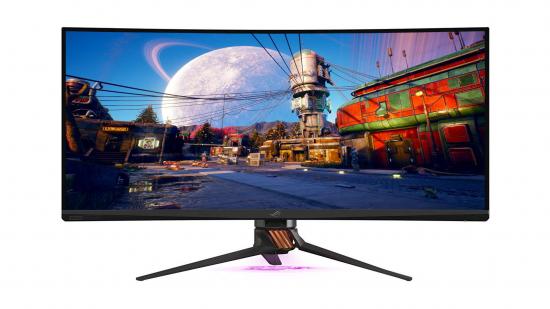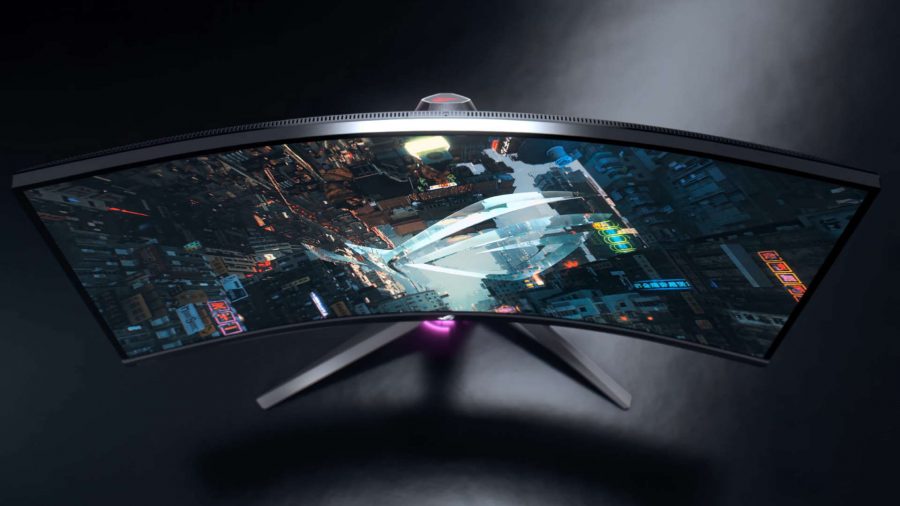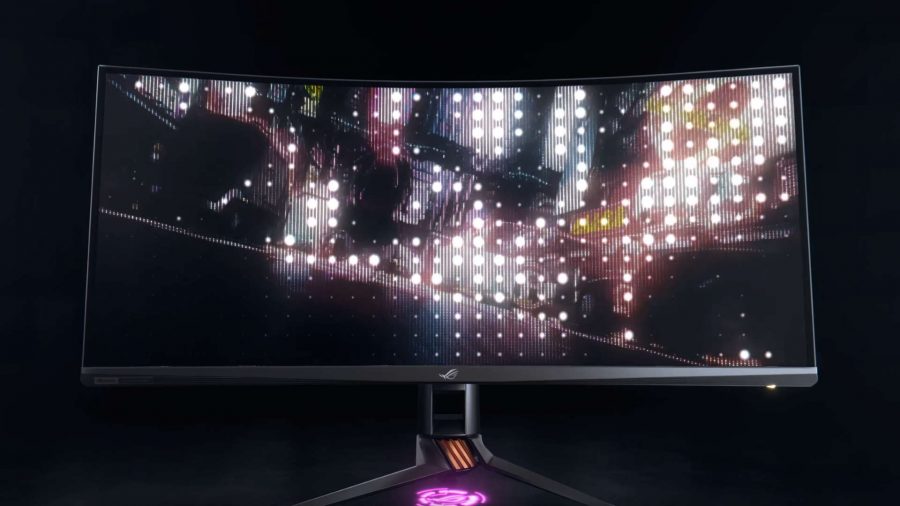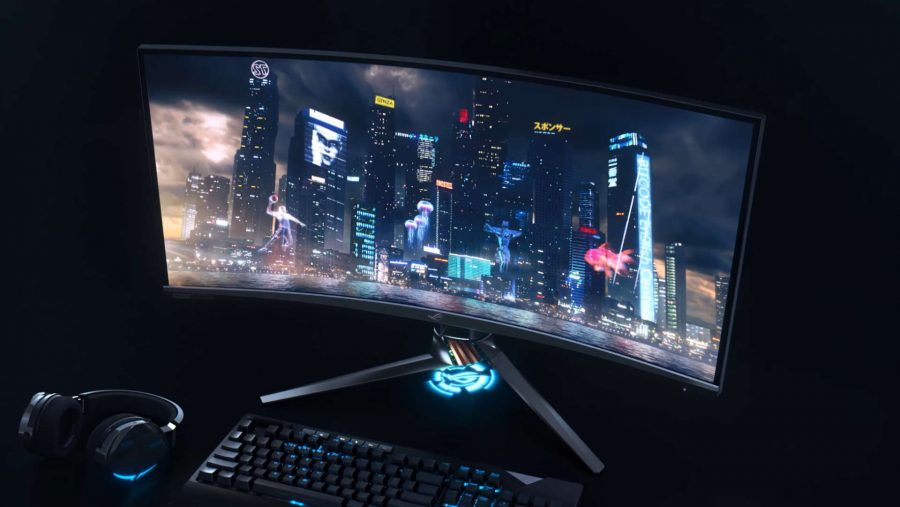Our Verdict
An outstanding, ultra high price ultrawide PC gaming monitor. And one that marries ultra high refresh rates, exemplary HDR support, and stunning SDR visuals... once you turn off that variable backlighting weirdness anyways.
There was one thing that almost had me hating the Asus Swift PG35VQ, which would have made me a very sad panda given that it’s almost everything I’ve ever wanted in a PC gaming monitor. And, almost inevitably, it was because of the flailing fustercluck that is HDR gaming on the PC.
There was an effect, a result of the super high specifications of this full DisplayHDR 1000 ultrawide beauty, that meant when you weren’t indulging in the spectacular HDR visuals this screen is capable of delivering it was a horror-show on the Windows desktop. I’m saying all this in the past tense because it’s no longer an issue. Not because I’ve learned to live with the dynamic backlighting making me want to tear out my eyeballs, but because I’ve turned it off in my normal SDR world.
And now I’m in love. Those 512 zones of local dimming are vital for the highs and lows of high dynamic range visuals, but when they’re tracking a bright mouse cursor over a dark screen, providing an ugly tracking halo of light around it just after you move, it’s beyond distracting. And when you’re being expected to pay more than $2,500 for the privilege that’s tough to square. But without them muddying up your PC’s SDR display, however, the PG35VQ becomes an absolute joy to use.
The Asus ROG Swift PG35VQ is a seriously high-spec gaming monitor, in a similar mold to the FreeSync-y Strix XG screens, but with a whole lot more in the way of extra luxuries. First of which is the fact this is a glorious ultrawide monitor, with the absolutely necessary 3440 x 1440 native resolution. Seriously, I have a very strict 21:9 height restriction and 1440 pixel is that limit. Show me a 1080 high ultrawide and I’ll show you the door. Head first. Without opening it first.
There’s a slight curve to the panel, which brings the edges of the 35-inch display just a little in towards you from the extremities. It’s barely noticeable when you’re in front of it, and honestly I’m not entirely sure of its value – beyond the obvious aesthetic – when the VA panel is so good in terms of the viewing angles.
| Asus ROG Swift PG35VQ | |
| Panel tech | VA |
| Native resolution | 3440 x 1440 |
| Refresh rate | 200Hz (overclocked) |
| Response time | 2ms |
| Curve | 1800R |
| Luminance | 500cd/m2 (typical) | 1,000cd/m2 (peak) |
| Price | $2,500 | £2,700 |
That panel can also be overclocked to a heady 200Hz and, unlike some overclocked screens I’ve tested, I’d be happy to run it at that speed continuously. Some high refresh rate displays struggle to get beyond 120Hz comfortably despite being technically able to run at up to 165Hz, but here the 200Hz refresh is more than stable. And looks great in game and on the desktop.
As it’s a Swift PG-series monitor it also come sporting the G-Sync hardware to deliver super-smooth PC gaming, synced up to the frame rate of your Nvidia graphics card. It’s rated as G-Sync Ultimate which puts it above standard G-Sync in that it offers the full DisplayHDR 1000 certification. That means the screen is capable of retina-searing peak luminance levels of 1,000cd/m2, though the Asus VA panel will typically run at 500cd/m2.
That’s still a lot brighter than your standard 350cd/m2 gaming monitor, and means it can nail the pin point bright lights of HDR gaming and video. And oh mamma, does it look good doing it.
There are few panels, beyond a Samsung QLED or LG OLED TV, that I’ve seen such good HDR performance from. The Swift PG35VQ uses a quantum-dot filter to help deliver the necessary colouring for a quality HDR image and the 512 zone backlighting helps bring the intense contrast.
Though this is where I had my initial issues with the Swift. Straight out of the box I felt the screen was dark and, as is my wont during monitor testing, I ran a factory reset before starting. It came back brighter, but also with the Variable Backlighting setting turned on. That was what was responsible not only for the halo effect around my mouse cursor, but also around any single bright spot on a SDR image.
It’s something you can turn off for SDR content in the monitor’s capable OSD, but it’s something which is necessary for HDR. As such, as soon as you enable HDR in the Windows desktop settings it comes back. The halo-ing is really frustrating, ignoring the cost, because this is the first screen I’ve used where I could otherwise happily run with the HDR mode left on. With Windows running in HDR mode it didn’t alter the standard dynamic range desktop the way it does on other screens.
Unfortunately some PC games still require you to have the Windows setting permanently enabled as they’re seemingly too dumb to be able to figure things out themselves. Boot up Far Cry New Dawn without enabling it in Windows and it still recognises you have a HDR screen attached and can switch it all on without you leaving the game. And therefore never having to suffer the pain of the halo.
For other modern games, like F1 2019, you have to quit out of the game and delve into your OS settings to be able to get the game to even give you the option to enable HDR. But I’ll almost forgive them when it looks so damned good…
Running Metro Exodus too looks stunning, whether inside or outside, and my go-to HDR tester, Resident Evil 7, ran almost flawlessly. I say ‘almost’ because it sadly still doesn’t have proper ultrawide support which won’t require you screw about with a hex editor just to get a close approximation of a fullscreen 21:9 experience.
That’s because, ignoring the backlighting niggles, the performance of the panel is excellent. The contrast is exemplary, the VA tech delivers the typically good black levels that you would expect, and the white saturation is as good as you could wish. There’s not a hint of banding in the gradient test and the viewing angles are utterly stable. You’re going to be sat front and centre with this screen while gaming, but for such a wide panel that’s still reassuring.
We do have to make a nod to the pricing of the PG35VQ. It’s a lot. Like, a real bad mega lot. When you’re looking at around the $2,500 mark that’s a huge chunk of change to be dropping on a screen. But it’s still in line with Asus’ other ultra-bright gaming monitors, such as the ROG Swift PG27UQ, and this is a far superior display than that.
You are running headlone into ultra-enthusiast monitor territory here, where money starts to make little sense. But I can’t think of any other high-priced PC panel I’d rather have sat on my desk. Jacob will argue the case for the 49-inch Samsung C49RG90, but while that has the scale, this has the panel, the refresh rate, and the brightness.
The Asus ROG Swift PG35VQ, in the end, is an outstanding gaming monitor. It’s good-looking – I’m even starting to come around to the funky stand and down-firing LED aesthetic – and makes HDR content genuinely pop. It still suffers from the PC’s propensity to totally screw up HDR, and the variable backlighting under SDR looks dreadful, but those are easy to manage away and you’re just left with a brilliant PC screen.



